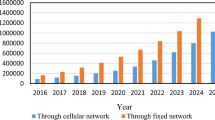Abstract
In this paper, we present bandwidth efficient selective retransmission method in conjunction with adaptive modulation and coding (AMC) scheme for OFDM waveform. In the proposed method, when a packet failure occurs, receiver requests retransmission of information symbols prone to error corresponding to the low signal-to-noise ratio (SNR) sub-carriers of OFDM modulation. The selective retransmission avoids unnecessary retransmission and AMC chooses a proper modulation and coding scheme with an objective to maximize the throughput. Our method achieves higher throughput as compared to conventional retransmission methods such as Chase combining hybrid automatic repeat reQuest (CC-HARQ) and incremental redundancy hybrid automatic repeat reQuest (IR-HARQ). We also provide the throughput and delay analysis of the proposed method for non-truncated ARQ. The simulation results demonstrate throughput gain without significant impact on delay as compared to the conventional retransmission approaches.








Similar content being viewed by others
References
Yu, P. S., & Lin, S. (1981). An efficient selective-repeat ARQ scheme for satellite channels and its throughput analysis. IEEE Transactions on Communications, 29(3), 353–363.
Huang, C.-Y., Chung, W.-C., Chang, C.-J., & Ren, F.-C. (2011). An intelligent HARQ scheme for HSDPA. IEEE Transactions on Vehicular Technology, 60(4), 1602–1611.
Cipriano, A. M., Gagneur, P., Vivier, G., & Sezginer, S. (2010). Overview of ARQ and HARQ in beyond 3G systems. In IEEE 21st international symposium on personal, indoor and mobile radio communications workshops (PIMRC Workshops) (pp. 424–429). IEEE.
Hu, T., Afshartous, D., & Young, G. (2004). Parallel stop and wait ARQ in UMTS-Performance and modeling. In Proceedings of the 2004 world wireless congress, San Francisco, CA.
Lin, S., & Yu, P. S. (1982). A hybrid ARQ scheme with parity retransmission for error control of satellite channels. IEEE Transactions on Communications, 30(7), 1701–1719.
Long Term Evolution of the 3GPP Radio Technology. Available http://www.3gpp.org. Accessed July 15, 2015
Chase, D. (1985). Code combining—A maximum-likelihood decoding approach for combining an arbitrary number of noisy packets. IEEE Transactions on Communications, 33(5), 385–393.
Introduction 2 hybrid ARQ—3gpp r1-01-0031, Available: http://www.3gpp.org. Accessed December 10, 2016
Alouni, M. S., & Goldsmith, A. J. (2000). Adaptive modulation over Nakagami fading channels. Wireless Personal Communications, 13(1), 119–143.
Webb, W., & Steele, R. (1995). Variable rate QAM for mobile radio. IEEE Transactions on Communications, 43(7), 2223–2230.
Fantacci, R., Marabissi, D., Tarchi, D., & Habib, I. (2009). Adaptive modulation and coding techniques for OFDMA systems. IEEE Transactions on Wireless Communications, 8(9), 4876–4883.
Goldsmith, A. J., & Chua, S.-G. (1998). Adaptive coded modulation for fading channels. IEEE Transactions on Communications, 46(5), 595–602.
Goldsmith, A. J., & Varaiya, P. P. (1997). Capacity of fading channels with channel side information. IEEE Transactions on Information Theory, 43(6), 1986–1992.
Zia, M., & Ding, Z. (2014). Bandwidth efficient variable rate HARQ under orthogonal space–time block codes. IEEE Transactions on Signal Processing, 62(13), 3360–3390.
Roberson, J., Dong, X., & Ding, Z. (2007). Channel estimation and equalization techniques in downsampled ARQ systems. IEEE Transactions on Signal Processing, 55(5), 2251–2262.
Zia, M., & Ding, Z. (2008). Joint ARQ receiver design for bandwidth efficient MIMO systems. In Proceedings of the IEEE global telecommunications conference, New Orleans, LA, USA (pp. 1–5).
Shi, T., & Cao, L. (2004). Combining techniques and segment selective repeat on turbo coded hybrid ARQ. In Proceedings of the IEEE wireless communications and networking conference (WCNC) (Vol. 4, pp. 2115–2119).
Muhammad, Z., Mahmood, H., Ahmed, A., Saqib, N., et al. (2013). Selective HARQ transceiver design for OFDM system. IEEE Communications Letters, 17(12), 2229–2232.
Shafique, T., Zia, M., Han, H. D., & Mahmood, H. (2016). Cross-layer Chase combining with selective retransmission, analysis, and throughput optimization for OFDM systems. IEEE Transactions on Communications, 64(6), 2311–2325.
Liu, Q., Zhou, S., & Giannakis, G. B. (2004). Cross-layer combining of adaptive modulation and coding with truncated ARQ over wireless links. IEEE Transactions on Wireless Communications, 3(5), 1746–1755.
Wu, D., & Ci, S. (2006). Cross-layer design for combining adaptive modulation and coding with hybrid ARQ. In Proceedings of the 2006 international conference on wireless communications and mobile computing (pp. 147–152).
Sassioui, R., Jabi, M., Szczecinski, L., & Benjillali, M. (2016). HARQ and AMC: Friends or foes? IEEE Transactions on Communications, 65(2), 635–650.
Jabi, M., Benjillali, M., Szczecinski, L., & Labeau, F. (2016). Energy efficiency of adaptive HARQ. IEEE Transactions on Communications, 64(2), 818–831.
Zia, M., Kiani, T., Saqib, N. A., Shah, T., & Mahmood, H. (2015). Bandwidth-efficient selective retransmission for MIMO-OFDM systems. ETRI Journal, 37(1), 66–76.
Proakis, J. G., & Salehi, M. (2008). Digital communications. New York: McGraw-Hill.
Bromwich, T. J. I. (1908). An introduction to the theory of infinite series. Basingstoke: Macmillan and Company Limited.
Liu, Q., Zhou, S., & Giannakis, G. B. (2005). Queuing with adaptive modulation and coding over wireless links: Cross-layer analysis and design. IEEE Transactions on Wireless Communications, 4(3), 1142–1153.
Acknowledgements
This work is supported by the URF grant No.FNS/16-1724 of Quaid-i-Azam University, Islamabad, Pakistan.
Author information
Authors and Affiliations
Corresponding author
Rights and permissions
About this article
Cite this article
Qadri, M.I., Zia, M. Adaptive Modulation and Coding with Selective Retransmission under OFDM signaling. Wireless Pers Commun 101, 1787–1805 (2018). https://doi.org/10.1007/s11277-018-5672-y
Published:
Issue Date:
DOI: https://doi.org/10.1007/s11277-018-5672-y




